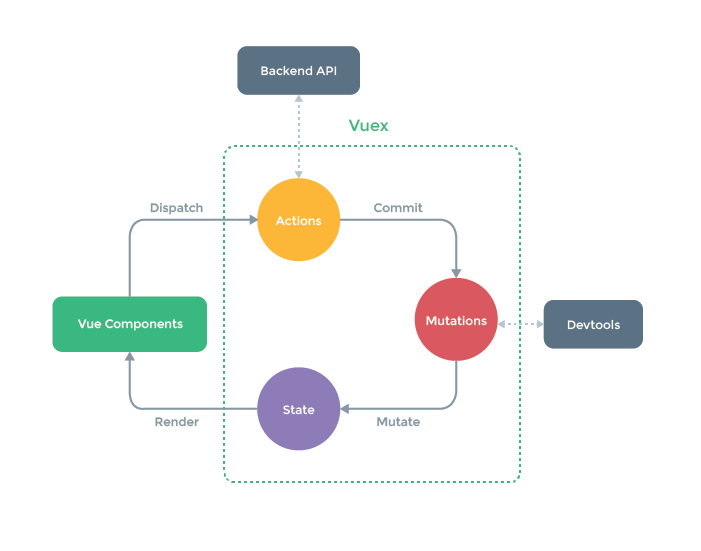Front end (Vue.js)
Vue.js is a JavaScript Framework that enables for creating user interfaces. It consists of HTML, CSS and JS and allows to extend HTML with HTML attributes that are called directives. These directives offer functionality and can be either built-in like for-loops or user-defined.
Vue.js itself is focused on the view layer. However with officially maintained packages, functionality for state-management, routing or build automation it can be extended.
Components
Components are reusable instances in Vue.js. Once created, they can be imported and used in the template of other components.
A simple example of a component would look like this:
<template>
<h1>This is an example component!</h1>
</template>
<script>
export default {
name: 'foo-bar',
data(){
return{}
}
}
</script>
<style scoped>
</style>
Components typically consist of these sections:
- Template section: HTML Markup with Vue.js components
- Script section: "Vue.js logic" -> All the data, methods and lifecycle logic live here
- Style section: Not mandatory, but possible for e.g. scoped styling for the specific component
With this component created, it can now be used like so in any other template:
<div id="components-demo">
<foo-bar></foo-bar>
<h2>Something here..</h2>
</div>
More on components is to be found in the official Vue.js documentation: https://vuejs.org/v2/guide/components.html
Directives
A minimal working example for the built-in directive that equals a for-loop looks like the following:
<ul>
<li v-for="item in items">{{item.text}}</li>
</ul>
The directive is called v-for and in this example iterates over the list object items. each individual object
is assigned by the name item that is defined here. Within the html list tag the {{item.text}} is a statement to access the text attribute of the item object.
The result of this would show a list of items with their text attributes, like the following:
- foo
- bar
- foobar
- bazbaz
Routing
To be able to see different views in the browser, it is important, to map created components to routes.
For example a component Foo.vue would be mapped to the route /foo and Bar.vue might be mapped
to /bar. This would look something like this:
const routes = [
{ path: '/foo', component: Foo },
{ path: '/bar', component: Bar }
]
This will make sure, that the Foo component will be rendered, when we are navigating to www.example.com/foo.
The router of this application is to be found in vue_frontend/src/dashboard/entry/router.js. In addition to the simple
mapping of routes and components, it is possible and also sometimes necessary to provide some business logic inside the router.
For instance it is possible to make sure, that an unauthorized user is being redirected to the /login route.
More on the vue-router is to be found at the official documentation: https://router.vuejs.org/guide/
State-management
This application uses the state management pattern/library vuex, which is the official supported state management for Vue.js. Vuex provides a centralized store for all the data of the application and therefore for all the different components, so that the data can be managed centralized. There are rules, ensuring, that the state can only be modified predictably.
The following diagram by Vuex/Vue.js gives an overview of the workflow with vuex:

The communication between the front end and therefore the store and the Back-end API only happens through so called actions, which are defined in the state-management. Changes will be then commited to mutations which will then mutate the state. The state is what is rendered inside the components. Whenever a state of some data is changing, the component will be re-rendering, as long as the principles of Vue.js and vuex are kept.
Inside vue components again, it is possible to trigger/dispatch such an action, that then again connects to a back-end API.
More on vuex is to be found on the official documentation: https://vuex.vuejs.org/#what-is-a-state-management-pattern
Static files / Deploying .vue files
To be able to display .vue files in a browser, they have to be converted to static files, i.e. HTML, CSS and JS source files.
This is happening by running the npm run build command. This triggers webpack, which bundles the .vue files to be deployed.
See https://webpack.js.org/ for more information.